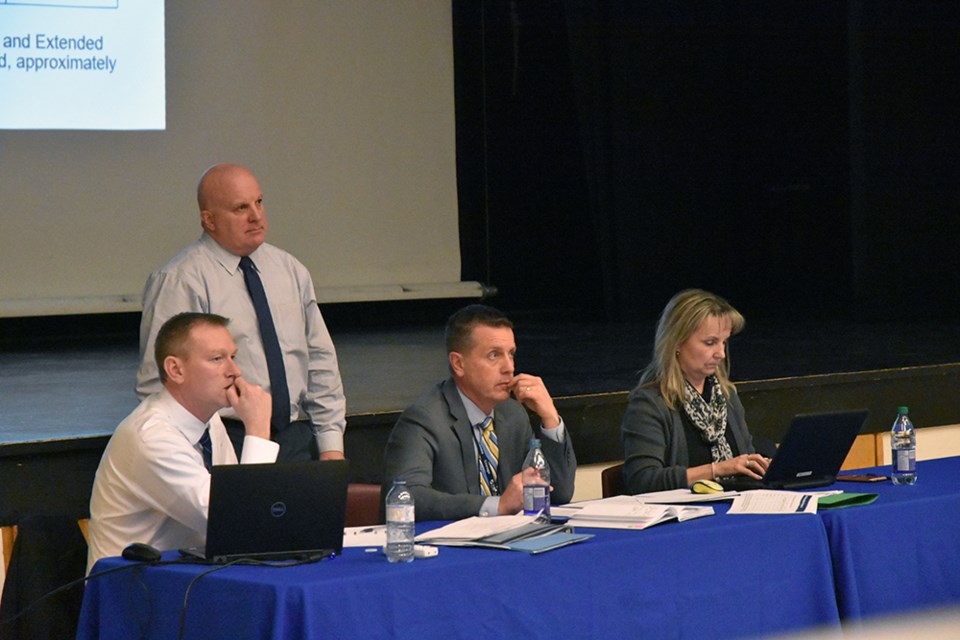About 50 parents attended a meeting called by the Simcoe County District School Board at Bradford District High School on Tuesday evening to hear details of the planned Bradford North Elementary School.
They didn’t like what they heard.
Not the details of the new school, as Superintendent of Education for Area 4 Daryl Halliday noted, that was good news: “A new school in Bradford is going to be a welcome addition.”
But until the new school opens, and even afterward, the status quo of overcrowded facilities and schoolyards filled with portables will continue.
The new school, with the capacity to accommodate 501 students, will be built north of Line 8 in Bradford West Gwillimbury, on a 2.8-hectare site on Crossland Boulevard between Rogers Trail and Kidd Street – but it won’t open until September 2022.
Until it opens, there will be no changes in school boundaries for the existing public elementary schools in Bradford – despite the fact that “we’re bursting at the seams,” said SCDSB Manager of Planning, Enrolment and Community Use Andrew Keuken.
“We’re all aware of the growth in Bradford,” Keuken said, but capital projects – new schools and additions – must be approved by the provincial Ministry of Education. He noted the last time the school board was asked to submit a list of its priorities was in 2017, when three of the Top 10 critical needs identified were in Bradford.
Funding was requested for two new elementary schools and a new high school in Bradford. Only one elementary school was approved, although the board has already purchased a property on Simcoe Road for a second.
The figures supported the need. Fieldcrest Elementary School, built to house 516 students, now has an enrolment of 858, and 15 portables. W.H. Day Elementary School, built for 559 students, houses 767 and has nine portables. Fred C. Cook Public School, built for 412, has 481 students and five portables.
And the new Chris Hadfield Elementary School, built for a student population of 501, now houses 803 students, and has 13 portables.
Only the rural schools, Hon. Earl Rowe Public School on Line 12 and Sir William Osler Public School in Bond Head, are currently under capacity, Keuken said.
All together, Bradford West Gwillimbury public schools are at 138 per cent capacity, with 849 more students than spaces.
“How do we get to 2022? One thing we don’t want to do is get into small transfers of students,” pulling kids from one school, only to move them again once the new school opens, said Keuken. “We’d rather avoid those many small changes over a long period of time.”
Instead, the board is closing overcrowded schools to out-of-area attendance requests, promoting the use of additional portables wherever there is space, and has designated two planned subdivisions at the south end of Bradford as “holding areas.” Once the houses are built, any students within those areas will be bused to Sir William Osler Public School.
“That’s our plan for the short term,” said Keuken. In the long term, there will be changes to the attendance boundaries, when Bradford North is built, and enrolment will be balanced at the Bradford schools to “create sustainable and stable school populations.”
But, he said, “things can’t change in the next three years.”
“For the next year and a half, Fieldcrest is going to continue to be as overcrowded, or more so?” demanded one parent, when the floor was opened to questions.
“Yes,” said Keuken.
“I was wondering why we’re over capacity by over 800 kids, and we’re building for 501 kids – and Bradford is continuing to grow,” said Devon Walsh, noting the new school won’t address current overcrowding.
Superintendent of Business and Facility Services Brian Jeffs responded by pointing to the province.
“They know we’re under incredible pressure here in Bradford,” said Jeffs. “We’re all sitting, waiting patiently but anxiously. Every day that goes by is three years down the road that Bradford doesn’t have a school.”
Until a second elementary school is approved, Jeffs said, “the portables are the only solution at this point in time, to be frank with you.”
The school board representatives were given examples of the overcrowding that is impacting student learning: music classes at W.H. Day “being held in the changerooms”; a kindergarten class housed for four months in the library at the school, disrupted every time the library was in use; the gym at Fieldcrest unable to accommodate all students, leaving some without physical education.
“Where’s the bottleneck?” demanded parent Daniel Enss, suggesting that some of the problems could be solved by the board by putting in more portables.
Jeffs noted that, going forward, it should be easier and quicker to get portables in place. The Town of BWG has agreed to pre-issue the building permits needed to install additional portables, and there are talks with the town regarding student use of the municipal library and leisure centre.
But the board will not allow empty portables to be used for classes like music – “for equity reasons,” said Jeffs – and the bottleneck continues to be the Ministry of Education.
“It’s just not a good environment for children to learn,” said parent Louis Vatrt, in frustration.
The SCDSB is looking for more input from parents. Contact [email protected].
